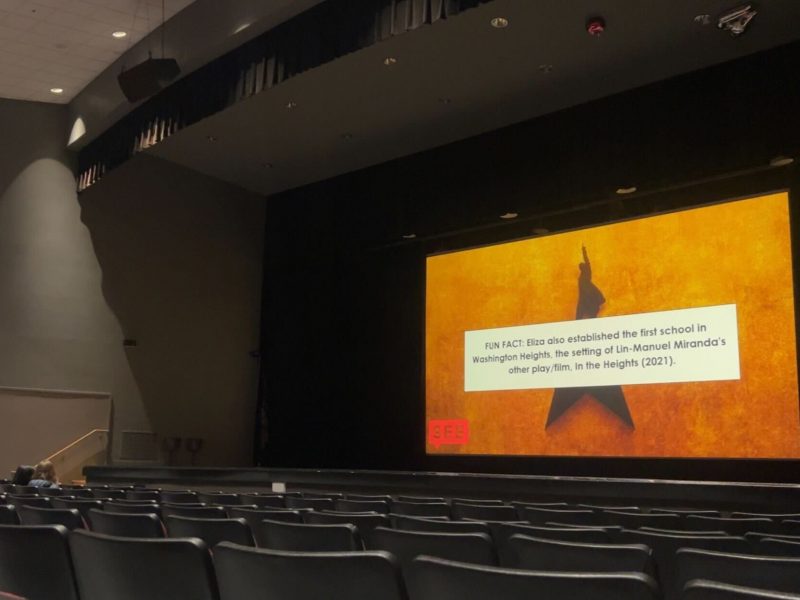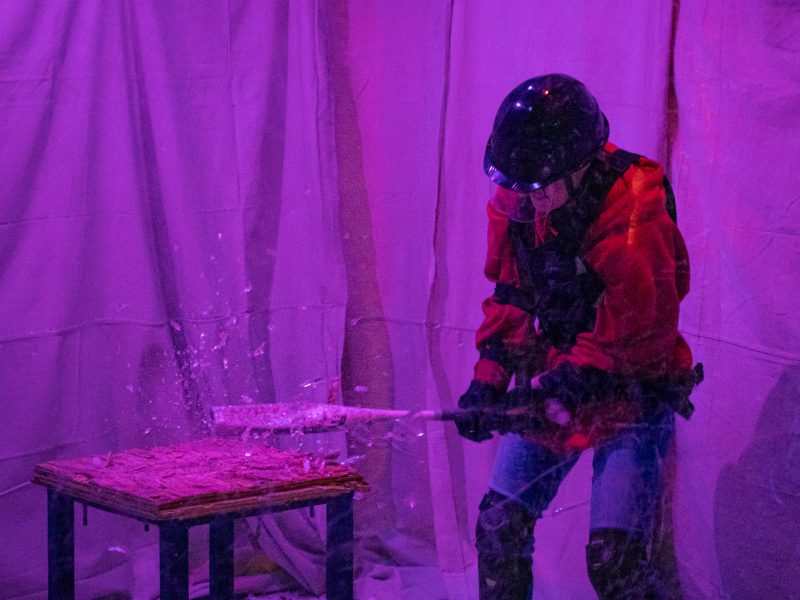At first, nothing in the picture seems out of the ordinary.
About 40 students don graduation robes and hats. Their faces solemn, the first row of recent graduates, all men, kneel on the ground. Backdropped by a pair of trees, another line of students stand tall behind their fellow pupils. It’s hard to make out in the aged black-and-white photograph, but on first glance, it seems they are all men, too.
In fact, there doesn’t appear to be any women in the picture at all — that is, until you look a bit closer.
There, in the middle of the group of students, is Elizabeth Hook, her robe the sole one with a streak of white down the middle as if to signify that she is something unique, something unheard of, something never seen before.
And that’s because Hook was.
That photograph is just one of nine hanging in the Portico Room in McKeldin Library’s second floor that, along with three glass cases filled with documents on the first floor, stands as a testament to the centennial celebration of a pivotal moment at the University of Maryland.
One hundred years ago on Sept. 14, 1916, Hook became the first woman accepted to this university who would spend four years here and graduate with a bachelors degree.
To mark this milestone, University archivists Anne Turkos and Amanda Hawk worked on a two-part exhibit to detail the achievements and roadblocks endured by the group of pioneering women that attended this university from the 1910s to late 1930s.
“I want (students) to know that it’s an important anniversary,” Turkos said. “A lot of people don’t realize at what point in our history women came here. I don’t think a lot of students know the early history or that the fact we were all-male for 60 years, basically, from the charter date.”
Restrictions and rebels
This university’s acceptance of women didn’t signal a halcyon period of gender equality.
Nowhere in the exhibit is this better illustrated than a brochure from the 1920s titled “The Girls of Maryland.” The document states that all classes are open to women at this university — with an important caveat.
This university “is laying stress on the development of work in home economics because it feels that is the particular field in which it can do the most for the future of womanhood in the state,” it reads. ” … The home is the social and economic unit of the nation. Women are the home-makers. It, therefore, follows that women should prepare themselves to make and maintain efficient homes.”

Elizabeth Hook. (Photo courtesy of the University Archives)
Women at this university also often faced restrictive rules regarding their behavior. But that didn’t stop Vivian Simpson, a vocal rebel admitted in 1921, who detested the double standards set for men and women on the campus.
Women were prohibited from smoking in their dorms, but men were not. Men could keep their lights on as long as they wished, but women had to turn them off by 10:30 p.m. Women had a 7:30 p.m. curfew during most weekdays and a 10:30 one on weekends, but men did not.
So Simpson refused to turn her lights off until late at night. She supported other women who smoked in the dorms. She greeted “gentleman callers” in her kimono.
This led to then-University President Albert Woods barring her from returning for her junior year. Simpson filed a suit asking for her readmission, but those efforts failed as the Maryland Court of Appeals upheld her expulsion.
Simpson finished her studies at George Washington University. She went on to become the first female president of the Montgomery County Bar Association and the first female Secretary of State for Maryland.
“I think she would have been an alum that we should have held on to,” Turkos said. “But she broke a lot of rules and they weren’t going to have any truck with that.”
Perseverance and progress
There were just more than 90 women enrolled at this university when Adele H. Stamp accepted the position as the institution’s first dean of women in 1922. Despite the challenges that group of women faced, they found success in various aspects of campus life in the past and would more easily flourish under the guiding force of Stamp.
A steely advocate for women, Stamp ushered in a slew of programs aimed at uplifting women at this university. She founded the annual May Day celebration in 1923, an event where junior women would nominate a senior to be the “May Queen,” and also started this university’s Women’s Senior Honor Society, which later became this university’s Mortar Board chapter, which sought the most academically successful female students.
Those steps would later culminate in a greater academic diversity among women, with Evelyn Barstow Harrison becoming the first woman to graduate with a degree in engineering, a field that remains overwhelmingly male to this day, in 1932.
Harrison’s refusal to be pigeonholed into a “woman’s major” at this university can be traced back to Hook, who bucked that trend by graduating with a degree in entomology, the study of insects. Hook proved no major was out of reach. A 1920 picture in the first-floor exhibit that depicts women working alongside their male counterparts in a laboratory shows the students who came after her took note.

Female students in the greenhouse. (Photo courtesy of the University Archives)
Women began to jump into athletics, too. In 1919, female students created an athletic association and began to plan games for sports like soccer, dodgeball and basketball.
But while most of the women’s sports teams were resigned to compete inter-class, this university’s all-women rifling team faced off against groups from other colleges by 1924. Team members would shoot at a target in the attic of the Skinner Building and telegraph the results to the competing team miles away because they were not allowed to travel.
The rifling team won two national championships as a group, and two members earned individual national championship titles as well, Hawk said.
“I don’t think any of the other teams at that point were really competing against other schools,” Hawk said. “It’s really interesting, and not something that most people think of when they think of women athletics.”
The university was still far from perfect, but it took some much needed steps — enough so that, when all the graduating women of the class of 1929 posed for a photograph together, they nearly matched the number of the students in the class of 1920 picture of all men and one lonely female.
Unfinished and unwritten
Ellin K. Scholnick, the chairwoman of the President’s Commission on Women’s Issues and faculty ombuds officer, joined the psychology department as an assistant professor in 1967 and found herself vastly outnumbered by men.
“When I came into my department, I was a rarity,” Scholnick said. “There were three women in the department of psychology, and only one was tenured. When I became tenured, I think I was number four in all of BSOS. I was the token woman on many committees, and that’s not a very pleasant position to be in.”
How are things today? Better, but still skewed.
A fall 2015 summary of salaried employees at this university from the Office of Institutional Research, Planning & Assessment shows near-parity in some positions that dissipates farther up the ladder.
Forty-seven and 48 percent of instructors/lecturers and assistant professors are women, respectively, according to the data. But women only make up 38 percent of associate professors and 24 percent of professors, suggesting the higher level the job, the more likely it is to be given to a man over a woman.
That gender inequity is also seen in the difference in crowd sizes between men’s and women’s sports. Despite posting a 371-108 record and winning the 2006 NCAA tournament under the tenure of coach Brenda Frese, the women’s basketball team — recognized as an official varsity sport in 1971 — can never quite seem to generate the same fan energy as the men’s team.
Frese said the university itself offers a great deal of support that enables the success of her team, which will represent the U.S. in the 2017 University Games in Taiwan. But she doubts that women’s basketball can ever be viewed in the same light as the men’s game.
“It’s never going to be equal to men’s basketball and football,” Frese said. “But for us to be a national power, you have to have a lot of support.”
Elected Student Government Association president last spring, Katherine Swanson said she hopes to advocate for improving the status of women’s health on the campus by pushing for a women’s center in this university’s health center and free tampons in university bathrooms.
But the importance of her presidency during this year is not lost on Swanson, who said she made a concerted effort to ensure her SGA cabinet was “woman-strong to have a lot of woman-power in it.”
“It’s interesting that this is coinciding — that we have a woman SGA president and this anniversary,” she said. “It shows how far we’ve come, but we still have a long way to go.”



